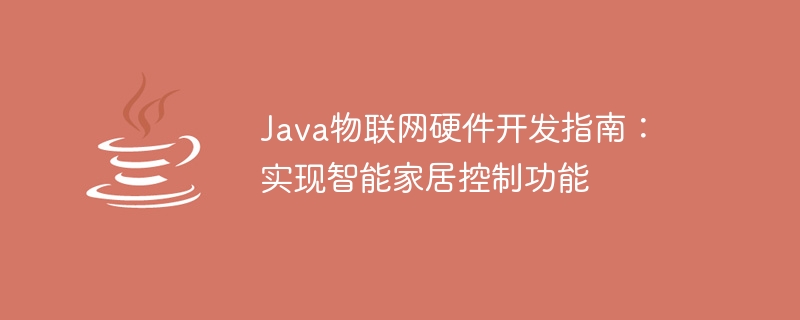

Java Internet of Things Hardware Development Guide: To implement smart home control functions, specific code examples are required
With the continuous development of Internet of Things technology, smart homes have become popular nowadays topic of. By combining Java programming language and IoT hardware development, we can realize smart home control functions. This article will introduce the principles of Java IoT hardware development and provide some specific code examples to help readers quickly get started developing smart home control functions.
The principle of Java IoT hardware development is mainly to realize function control through communication between Java language and hardware devices. We can obtain environmental information through sensors, such as temperature, humidity, light and other data, and then process and control related equipment through Java programs. Smart home control functions generally include lighting control, temperature control, door and window control, security control, etc. Below we will give some specific code examples to help readers understand and practice the process of Java IoT hardware development.
import java.io.IOException;
import javax.bluetooth.BluetoothStateException;
import javax.bluetooth.DiscoveryAgent;
import javax.bluetooth.LocalDevice;
import javax.bluetooth.RemoteDevice;
public class LightControl {
private RemoteDevice device;
private boolean lightOn;
public LightControl(String address) throws BluetoothStateException {
device = LocalDevice.getLocalDevice().getRemoteDevice(address);
lightOn = false;
}
public void turnOn() throws IOException {
// 通过蓝牙发送指令给硬件设备,控制灯光开启
// 示例代码仅作为演示用途,真实的指令需要根据硬件设备的通信协议来编写
// 例如:device.sendCommand("ON");
lightOn = true;
}
public void turnOff() throws IOException {
// 通过蓝牙发送指令给硬件设备,控制灯光关闭
// 示例代码仅作为演示用途,真实的指令需要根据硬件设备的通信协议来编写
// 例如:device.sendCommand("OFF");
lightOn = false;
}
public boolean isLightOn() {
return lightOn;
}
public static void main(String[] args) {
try {
LightControl control = new LightControl("00:11:22:33:44:55"); // 替换成真实的蓝牙设备地址
control.turnOn(); // 开启灯光
System.out.println("灯光状态:" + control.isLightOn());
control.turnOff(); // 关闭灯光
System.out.println("灯光状态:" + control.isLightOn());
} catch (BluetoothStateException | IOException e) {
e.printStackTrace();
}
}
}The above code controls the light switch of the hardware device through Bluetooth communication, which is off by default. First, we need to get the address of the Bluetooth device and get the Bluetooth device object through the LocalDevice.getLocalDevice().getRemoteDevice(address) method. Then, control the light switch by calling the turnOn() and turnOff() methods. Finally, we can get the current light status through the isLightOn() method.
import java.io.BufferedReader;
import java.io.IOException;
import java.io.InputStreamReader;
public class TemperatureControl {
private double temperature;
public double getTemperature() {
// 获取温度传感器的数据
// 示例代码仅作为演示用途,真实的数据获取需要根据硬件设备的通信协议来编写
// 例如:temperature = sensor.getValue();
temperature = 25.0;
return temperature;
}
public void turnOnAirConditioner() throws IOException {
// 如果温度高于设定的阈值,则通过Java程序控制空调开启
if (temperature > 25.0) {
// 控制空调开启
}
}
public void turnOffAirConditioner() throws IOException {
// 如果温度低于设定的阈值,则通过Java程序控制空调关闭
if (temperature < 25.0) {
// 控制空调关闭
}
}
public static void main(String[] args) {
TemperatureControl control = new TemperatureControl();
double temperature = control.getTemperature();
System.out.println("当前温度:" + temperature);
try {
control.turnOnAirConditioner(); // 开启空调
control.turnOffAirConditioner(); // 关闭空调
} catch (IOException e) {
e.printStackTrace();
}
}
}The above code obtains the current temperature data through the temperature sensor, which defaults to 25.0 degrees Celsius. Then, determine whether the temperature is higher than the set threshold by calling the turnOnAirConditioner() and turnOffAirConditioner() methods, and control the air conditioning switch based on the results.
Through the above two code examples, we can see the basic process of communication between Java language and IoT hardware. However, it should be noted that the real hardware device communication protocol needs to be written according to the actual situation, and the normal communication between the hardware device and the Java program needs to be ensured. At the same time, security and performance issues also need to be taken into consideration, such as encrypted transmission of data and optimization of response time.
To sum up, Java IoT hardware development can help us realize the control function of smart home. By rationally using the characteristics of the Java language and the technology of IoT hardware, we can flexibly control smart home devices and improve the convenience and comfort of home life. We hope that the code examples provided in this article can inspire readers in their Java IoT hardware development and further improve the level and capabilities of smart home control.
The above is the detailed content of Java IoT Hardware Development Guide: Implementing Smart Home Control Functions. For more information, please follow other related articles on the PHP Chinese website!
